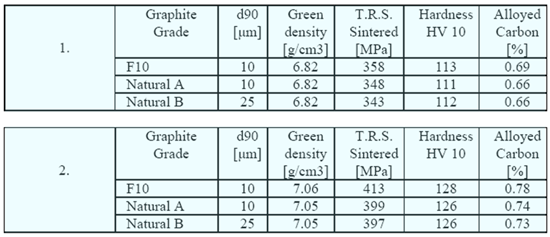PM-11 Conference Report: Graphite selection for use in PM parts production
The following exclusive review for www.ipmd.net by Professor Ramamohan Tallapragada reports on a paper presented by TIMCAL Ltd, Switzerland, discussing the selection of natural or synthetic graphite for use in PM part production. The event took place in Pune, India, from the 3rd to 5th February 2011
Luigi Alzati, Dr Raffaele Gilardi and Dr. Desmond Ng. of TIMCAL Ltd, Switzerland, presented a paper showing how an optimised selection of graphite powder addresses the three key-variables of performance, price and precision of PM parts in terms of dimensional tolerance and stability.
During sintering of ferrous PM parts graphite is almost completely reacted by diffusing into the iron matrix, so as to achieve a desired level of mechanical performance (i.e. hardness, tensile properties, and fatigue endurance). In applications like sinter-metallic brake pads, iron, copper or bronze-based bearings and PM valve guides, graphite diffuses into the iron as well as remaining un-reacted inside the pores, there by contributing to solid lubrication.
Selection of graphite
The selection of graphite is based on whether it is natural or primary synthetic, its ash content and the d90 particle size distribution, as finer powders are expensive.Experiments were conducted by mixing separately both natural and synthetic graphite powders in three different d90 particle sizes, 10μm, 25μm, and 44μm to ANCORSTEEL B +0.65%C +2%Cu. +0.8% wax from Hoeganaes Corporation and ATOMET DB46 +0.6%C +0.6% wax from QMP – Rio Tinto Powders respectively. The type of graphite, primary synthetic or natural, with d90 in the range of 10μm-44μm did not seem to affect the flowability of the mixed powders.
As a cost saving operation the impact of shifting d90 of natural graphite from 10μm to 25μm on medium-low density parts is investigated. The weight consistency of powder during compactions of over 8000 water pump pulleys made from powder mixes consisting of Fe +1.5%Cu +0.65%C +0.8% lubricant was investigated.
Results showed a slight gain in weight standard deviation (8 to 9%) when shifting from 10μm to 25μm d90 natural graphite.
Earlier dilatometer studies showed enhanced sintering activity of synthetic graphite verses natural. In mixes containing Cu-powder, it was found that a crucial parameter is the time available for graphite diffusion in steel particles prior to copper’s melting point. Sintering time must be sufficiently high to ensure a complete diffusion of carbon from graphite, a relatively low and constant copper growth and lower dimensional variation.

Table 1 Mechanical properties and percentage of alloyed carbon in various Fe-0.8%C steels with Primary Synthetic Graphite F10 and Natural Graphite A and B: (1.) NC100.24, (2.) ASC100.29 +0.8%C +0.8%Zn-Stearate. Sintering conditions: 1120°C for 30 min. in 90/10 N2/H2 (courtesy of Höganäs AB)
Höganäs AB sponge iron mix SC100.26 +3%Cu +0.5%C +0.3MnS +0.75% Kenolube was compacted to three green densities levels in separate experiments with additions of primary synthetic graphite F10 and natural graphite A (table 1). Sintering was performed at 1120°C for 30min in Endo gas and no dimensional change was observed at a low green density of 6.49g/cc. An increase in green density had increased the gap in dimensional change between natural graphite and primary synthetic graphite F10. Because of very minor dimensional changes, synthetic graphite is the preferred choice for dimensional control of relatively high density PM parts. Also, the sintered parts containing F10 showed higher transverse rupture strength.
Mechanical properties varied with different levels of alloyed carbon in the sintered bars containing F10, mostly due to enhanced diffusion of carbon into the iron matrix during sintering, compared to those containing natural graphite. Higher macro-hardness and T.R.S. were achieved at same density level suggesting that primary synthetic graphite can result in higher hardenability.
Comparable results were obtained in mass production trials of heavy sprockets by Metaldyne and QMP-Rio Tinto Powders. The 0.9%Ni-1%Mo-0.5%Mn-0.5%Cr alloyed powder ATOMET4701 was mixed with 2%Cu and 0.9%Graphite; sintering was performed at 1140°C for 25min. in a 90%/10% N2/H2 atmosphere. By using Synthetic instead of Natural Graphite the distribution of the sprockets’ outer diameter showed significantly lower standard deviations: lot-to-lot standard deviation was reduced by 40% and the part-to-part standard deviation was reduced by 55% under mass production conditions. As a result, the PpK (Critical Process Capability) was improved by 45%.
Conclusion
In general, low density (<6.8g/cc) parts, such as water pump pulleys, benefited from natural graphite of 25μm-d90. Medium density high carbon parts, such as valve guides, may benefit from a mixture of natural and synthetic graphite, while high density grades will be improved by the addition of synthetic graphite.
News | Articles | Market reviews | Search directory | Subscribe to e-newsletter





